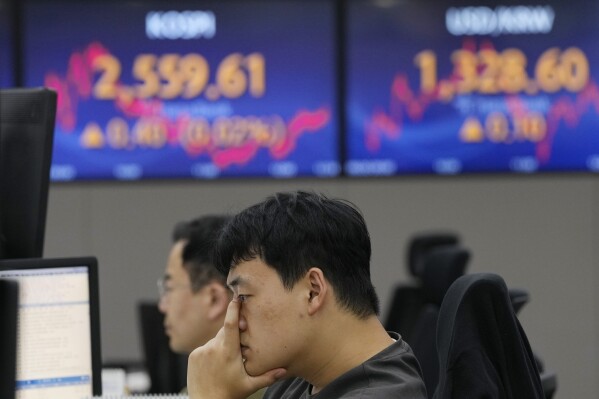What will Federal Reserve do next? Any hint of future rate hikes will be key focus of latest meeting
WASHINGTON (AP) — The Federal Reserve is set to leave its key interest rate unchanged Wednesday as it seeks to guide the U.S. economy toward a “soft landing” of cooling inflation without triggering a deep recession.
Chair Jerome Powell and other Fed officials have made clear that they’re now inclined to move more gradually and cautiously toward their goal of 2% annual inflation. Their more deliberative approach follows the 11 rate hikes they unleashed beginning in March 2022, which substantially raised borrowing costs for consumers and businesses.
Yet with inflation pressures still underlying the economy, Powell won’t be declaring victory on Wednesday, when the Fed’s latest policy meeting ends. The attention of investors and economists will instead focus on what signals the Fed may send about its likely next actions.
The clearest signal will likely come from the Fed’s 19-member interest-rate committee in the batch of economic forecasts its members issue each quarter. The updated projections are likely to show that the policymakers expect to raise their benchmark rate once more this year. That rate now stands at roughly 5.4%, its highest point in 22 years.
 Did your kids buy gear in Fortnite without asking you? The FTC says you could get a refund
Did your kids buy gear in Fortnite without asking you? The FTC says you could get a refund
 Stock market today: Asian shares decline ahead of Fed decision on rates
Stock market today: Asian shares decline ahead of Fed decision on rates
 Foreign firms in China say vague rules and tensions with Washington hurting business, surveys show
Foreign firms in China say vague rules and tensions with Washington hurting business, surveys show
And those projections will likely also show that the Fed envisions fewer interest rate cuts next year than it did in June, when it projected three rate reductions in 2024. Even as the central bank is winding down its rate hikes, Powell and other Fed officials have said their key rate could remain at its peak well into next year. Analysts expect the Fed’s forecasts Wednesday to show just one or two rate cuts in 2024.
Further clues about the future path of the Fed’s interest rate policy could emerge at a news conference Powell will hold after the central bank issues a policy statement and its quarterly economic projections.
In raising its short-term interest rate at the fastest pace in four decades, the Fed has sought to moderate borrowing and spending, slow the economy and tame inflation. So far, consumer inflation, measured year over year, has tumbled from a peak of 9.1% in June of last year to 3.7% in August. Yet it’s still well above the Fed’s target.
Powell and other central bank officials have said that while they are making progress, they aren’t yet done. Even as overall inflation has declined, the cost of many services — from auto insurance and car repairs to veterinary services and hair salons — are still climbing faster than they were before the pandemic.
Still, most recent data is pointing in the direction the Fed wants to see: Inflation in June and July, excluding volatile food and energy prices, posted its two lowest monthly readings in nearly two years.
And signs have grown that the job market isn’t as robust as it had been, which helps keep a check on inflation: The pace of hiring has moderated. The number of unfilled openings fell sharply in June and July. And the number of Americans who have started seeking work has jumped. This has brought labor demand and supply into better balance and eased the pressure on employers to raise pay to attract and keep workers, which can lead them to raise prices to offset higher labor costs.
Yet the path back to lower inflation has already become more uneven: On a monthly basis, consumer prices jumped 0.6% in August, the most in more than a year. Compared with a year earlier, prices rose 3.7%, the second straight such increase.
Some emerging factors, meantime, are threatening to re-ignite inflation, weaken the economy, or both. Rising oil prices, for example, are making gasoline steadily more expensive. Should that trend continue, it would worsen inflation and leave consumers with less money to spend.
Next month, millions of Americans will have to resume their student loan payments when a pandemic-era pause ends. Even the so-far limited strike by the United Auto Workers union against the Big 3 U.S. automakers could slow growth and further inflate vehicle prices.
This week’s Fed meeting comes as central banks around the world are mostly raising rates to fight inflation. Prices spiked after the pandemic hampered global supply chains, causing shortages and higher prices. Inflation worsened after Russia’s invasion of Ukraine in February 2022 sent oil and other commodity prices spiking.
The European Central Bank raised its benchmark rate last week for the 10th time to 4%, the highest level on record since the euro was established in 1999, though it signaled that it could be its last hike. The Bank of England is also expected to increase its rate when it meets Thursday. The Bank of Japan, which meets Friday, is under less pressure to boost rates, although it has taken steps to allow Japanese long-term rates to tick up.
Disclaimer: The copyright of this article belongs to the original author. Reposting this article is solely for the purpose of information dissemination and does not constitute any investment advice. If there is any infringement, please contact us immediately. We will make corrections or deletions as necessary. Thank you.







